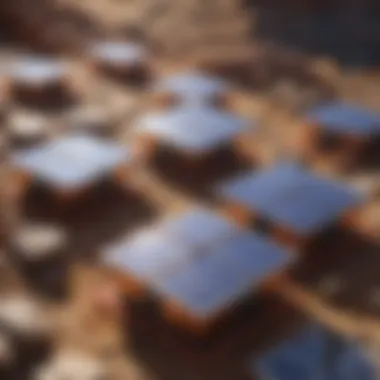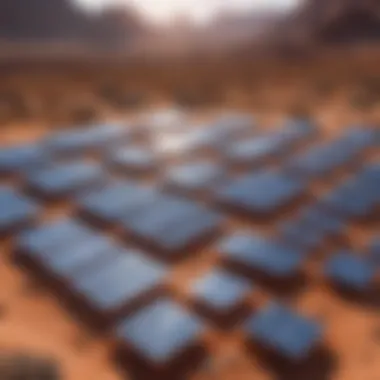Exploring 3D Solar Cells: Structure, Benefits, Future Trends


Intro
The growing demand for renewable energy sources has spurred significant advancements in photovoltaic technologies, with 3D solar cells standing out as a particularly promising option. Unlike their traditional 2D counterparts, 3D solar cells employ innovative structural designs that enhance their efficiency and versatility in energy harvesting. With layers that are judiciously arranged in three dimensions, these cells can capture sunlight from various angles, improving performance, especially in less-than-ideal weather conditions.
This article seeks to explore the intricate world of 3D solar cells, examining their structure, operational principles, and the myriad benefits they offer to the renewable energy sector. Through understanding these aspects, we can appreciate the pivotal role these cells play in advancing sustainability efforts and combatting climate change. Furthermore, we will delve into the challenges faced, potential applications, and the technology's future directions, offering an in-depth perspective that caters to students, researchers, and professionals alike.
As we embark on this exploratory journey, we will touch on recent advances in the field, introducing the cutting-edge discoveries and technological innovations that are paving the way for a more sustainable energy landscape. The in-depth examination will guide us to a broader understanding of the efficiencies, environmental considerations, and transformative potential that 3D solar cells hold. By synthesizing information from various domains, this analysis aims to provide valuable insights into how solar energy technology can evolve to meet the challenges of tomorrow.
Preamble to Solar Energy Technologies
Understanding solar energy technologies is not just about capturing sunlight; it's about how we can transform this abundant resource into usable energy. The increasing demand for clean energy solutions has propelled advancements in solar technologies, especially photovoltaic cells. As these technologies evolve, so too does our ability to harness solar power efficiently and effectively. This discussion serves as a gateway into the world of solar energy, especially focusing on the innovative aspects of 3D solar cells.
Solar energy has established itself as a cornerstone of sustainable energy initiatives. Traditional solar cells have played a significant role in this transition. However, with a rapidly changing energy landscape, innovation is the name of the game. The significance of exploring advanced technologies, like 3D solar cells, cannot be overstated. They promise higher efficiency rates and offer new avenues for integrating solar energy into diverse applications.
Here are key elements driving this exploration in solar energy technologies:
- Efficiency Improvements: Newer designs are breaking barriers with regards to energy conversion. This is vital in a world increasingly mindful of energy consumption.
- Sustainability Considerations: Environmentally friendly materials and methods are now at the forefront of development, ensuring that solar technologies don’t compromise our planet's health.
- Integration Potential: As smart technologies gain traction, understanding how solar cells can fit into these systems is critical.
As we delve into the evolution of photovoltaic cells and examine the shifting paradigms in solar cell design, it becomes clear that the journey toward efficient solar adoption is just beginning.
The Evolution of Photovoltaic Cells
The first photovoltaic cells emerged in the 19th century, showcasing a grassroots interest in harnessing sunlight for energy. Over the decades, technologies have undergone tremendous transformation. Early cells were extremely inefficient, converting only a small fraction of sunlight into usable electricity. However, advances driven by research and technological innovations have drastically changed the landscape.
For instance, the rise of monocrystalline and polycrystalline silicon cells in the late 20th century marked a significant shift. These materials allowed for higher efficiency rates and greater energy production, making solar energy more commercially viable. Notably, modern advancements have paved the way for thin-film technologies and, more recently, 3D geometries that maximize surface area for light absorption.
"Each leap in technology has not only amplified efficiency but also made solar energy more accessible to the average consumer."
Additionally, diverse applications have emerged; from residential rooftops to large-scale solar farms, flexibility in usage has been a game changer. Innovations in manufacturing processes have also allowed for more cost-effective solutions that cater to various market needs.
Shifting Paradigms in Solar Cell Design
With the development of 3D solar cells, the narrative around solar energy design is definitively changing. Traditional solar cells were essentially flat panels, which, while effective, left a lot on the table in terms of energy capture. The introduction of three-dimensional designs changes the rules of engagement.
3D solar cells utilize vertical structures that can capture sunlight from multiple angles, thereby optimizing the energy conversion process. These designs leverage advanced materials and construction techniques like nanostructures, which enable better photon absorption.
Such revolutionary approaches grant solar cells a level of versatility unseen before:
- Improved Light Capture: The angular design captures more sunlight throughout the day.
- Space Efficiency: 3D structures can produce more energy without necessarily increasing the footprint, making urban installations more feasible.
- Scalability: The technology can be adapted from small devices to larger terraces, accommodating various installation environments.
This shift brings to light the importance of ongoing research in the field, as scientists, engineers, and innovators work collaboratively to refine these technologies further. Understanding these dynamics is crucial for anyone vested in the future of energy markets and renewables.
By exploring the evolution of photovoltaic cells and examining recent paradigm shifts, we can grasp how 3D solar cells stand as potential game changers in the quest for sustainable energy solutions.
Understanding 3D Solar Cells
The exploration of 3D solar cells is becoming increasingly significant in discussions around renewable energy. Their structural designs open new avenues for improved efficiency, which traditional models struggle to keep up with. This section will explore the nuances of 3D solar cells, highlighting their unique characteristics, the cutting-edge materials used, and the construction techniques that set them apart. Understanding this technology not only illuminates the future of solar energy but also emphasizes its potential to contribute significantly to sustainable energy landscapes.
What Distinguishes 3D Solar Cells from Traditional Models
In the realm of photovoltaic technology, 3D solar cells stand out for their innovative designs. Unlike conventional flat solar panels, which operate on two-dimensional surfaces, 3D cells use vertical and three-dimensional structures to capture sunlight more effectively. This method of orientation allows for a larger surface area to be exposed to sunlight, significantly enhancing the energy absorption rate.
One could liken traditional solar cells to a pancake, flat and limited in reach, while 3D solar cells resemble a multi-layered cake, drawing on various surfaces for energy capture. Additionally, the complexity of their structure enables the utilization of multiple active materials—resulting in higher efficiency under varying light conditions.
Moreover, 3D solar cells often incorporate advanced light-trapping mechanisms. This means they can harness light that would typically be reflected away in traditional models. Consequently, these cells bring to the table not just enhanced efficiency but also versatility in various environments, making them suitable for applications on rooftops, vehicles, and even portable gadgets.
The Materials Behind 3D Solar Cell Technology
Central to the advancement of 3D solar cells is the selection of materials utilized in their construction. Recent innovations have introduced materials that not only boost energy conversion efficiency but also improve durability in different climates.
Commonly utilized materials include:
- Perovskites: Known for their excellent light absorption capabilities, these compounds have become the cornerstone of many 3D solar cell designs. Their adaptability and cost-effectiveness position them ahead of traditional silicon in many applications.
- Organic photovoltaic materials: These are gaining traction as they offer lightweight options that are well-suited for unconventional structures, including textiles and flexible surfaces.
- Nanomaterials: Incorporating nanostructures can enhance the charge separation process, leading to better overall performance of the solar cells.


The strategic combination of these materials allows for the optimization of the structural architecture, creating a delicate balance between weight, efficiency, and versatility ensuring that 3D solar cells not only perform better but also last longer.
Construction Techniques: A Closer Look
The methods employed in constructing 3D solar cells play a vital role in their effectiveness. Various techniques are utilized to achieve the three-dimensional structures, each with its unique benefits. Here are a few noted approaches:
- 3D Printing: This technique allows for complex designs that would otherwise be difficult to create using traditional manufacturing methods. It enables custom shapes and configurations, resulting in maximized light absorption.
- Layering Methods: By stacking different materials in layers, manufacturers can tailor the properties of the cell to suit specific energy conversion goals. This results in optimized light absorption at various wavelengths.
- Etching and Molding: These techniques help create microstructures that enhance the light-capturing abilities of the solar cells. The methods allow for increased surface area while keeping the overall size manageable.
Ultimately, the combination of these sophisticated techniques aids in the fine-tuning of energy capture systems. Each advancement in construction brings us closer to more efficient solar energy solutions, driving the transition toward sustainable energy futures.
"The road to solar innovation is paved with the marriage of unique materials and cutting-edge construction techniques, redefining how we harness sunlight."
In summary, delving into the intricacies of 3D solar cells reveals a world full of possibilities. The distinctions from traditional models, coupled with innovative material usage and advanced construction techniques, set the stage for a more efficient energy landscape.
Advantages of 3D Solar Cells
The rise of 3D solar cell technology marks a significant evolution in the solar energy landscape. Understanding the advantages these advanced systems offer is crucial for anyone delving deeper into renewable energy solutions. The production and operation of energy are not just about efficiency; they also signify how we harvest the sun's abundant resources. In this section, we'll explore several key benefits of 3D solar cells, focusing on their energy efficiency, cost-effectiveness, and wide versatility.
Enhanced Energy Efficiency: Mechanisms and Benefits
When we talk about solar cells, energy efficiency is often the name of the game. 3D solar cells are crafted to capture sunlight more effectively than their flat counterparts. The three-dimensional structure allows for better light absorption, which is particularly useful in varied weather conditions. This not only maximizes usage but also translates to better overall performance.
In practice, enhanced energy efficiency can result from several mechanisms. For instance, the architecture of 3D solar cells can employ light-trapping techniques that optimize the path of sunlight as it enters the cell. This unique design is important as it increases the likelihood of photon absorption, thus producing more electricity. Data indicate that these cells can yield higher output, especially in urban environments where rooftop space is at a premium.
Additionally, the variety of materials used, such as perovskite and organic photovoltaics, further bolsters efficiency. Depending on the specific setup, some reports suggest that efficiency rates could reach upwards of 30%. All in all, these factors contribute significantly to making 3D solar cells a vital player in the quest for cleaner energy solutions.
Cost-Effectiveness over Time
Cost is another major determinant in the adoption of solar technology. It’s not merely about the initial investment but also the long-term financial implications. One standout aspect of 3D solar cells is their potential for improving cost-effectiveness over time. While the upfront manufacturing costs can sometimes be higher due to their complexity, the robust output and efficiency often justify this spend.
Over their lifespan, 3D solar cells promise lower maintenance and operational costs. Their efficiency figures mean they generate more electricity from the same amount of sunlight, reducing the payback period. By comparison, homes or facilities using traditional solar panels might find their ROI lagging behind due to less optimal energy yield.
It's also worth mentioning the declining costs of production for various materials involved in 3D solar cells. As innovations in the manufacturing process continue, economies of scope and scale are expected to further drive down these costs. By taking a long view, stakeholders can see the value proposition solidifying over time.
Versatility in Applications
One of the most compelling advantages of 3D solar cells is their versatility. They can be adapted to a myriad of applications, spanning residential, commercial, and even industrial uses. For example, their unique form-factor allows for incorporation into unconventional surfaces, like building facades, car roofs, or even clothing.
Furthermore, these cells perform admirably in different environments. In limited space, they can be mounted on rooftops where traditional panels may not fit, taking advantage of vertical installations. In urban settings, where rooftops are often cluttered or obstructed, 3D configurations provide solutions by harnessing additional light through innovative arrangements.
Additionally, the lightweight nature of many 3D solar technologies enables their integration into portable devices or off-grid locations, catering to those who live in remote areas. The capacity to innovate, combined with an expansive range of use-cases, makes 3D solar cells anything but one-dimensional.
"As our energy needs evolve, so too must our technologies. The adaptability of 3D solar cells signifies much more than just improving efficiency; it's about redefining how we view solar energy in the modern landscape."
To encapsulate, the advantages of 3D solar cells lie not only in their cutting-edge technology but also in their transformative potential for the energy sector. Enhanced efficiency, a promising cost model, and remarkable versatility stand as testaments to how these cells could shape the future of solar energy.
Challenges in 3D Solar Cell Development
In the ever-evolving field of solar energy, developing 3D solar cells introduces a set of unique challenges that cannot be overlooked. As this technology continues to push boundaries, it is crucial to assess these hurdles to refine production techniques and optimize performance. Understanding these challenges not only helps in advancing the technology but also illuminates the broader implications for renewable energy.
Manufacturing Complexities
The realm of manufacturing 3D solar cells is laden with intricacies. Unlike traditional flat solar panels, which often follow a straightforward assembly process, the fabrication of 3D cells demands a high degree of precision and innovative approaches. Techniques such as two-photon lithography, or even advanced printing technologies, come into play.
Each layer of the cell must be aligned meticulously, ensuring optimal light absorption and efficiency. Small errors in the positioning can lead to significant losses in performance. Additionally, the need for specialized equipment may inflate production costs, deterring widespread adoption. Strategies must be devised to simplify this process, potentially making it more accessible to manufacturers.
Material Durability and Lifespan
Another pressing challenge is the durability of materials used in 3D solar cells. Given the intricate design, with multiple layers often composed of various materials, it can be difficult to ensure that these components endure environmental stressors. The resilience of materials against degradation from UV radiation, moisture, and temperature fluctuations is vital for the longevity of solar cells.
For instance, while silicon might be a durable option in traditional systems, its performance in a three-dimensional architecture may not be as robust, leading to questions of lifespan and reliability. Addressing these concerns necessitates ongoing research into superior materials that can withstand the rigors of time while maintaining performance.
Integration with Existing Energy Systems
The transition to 3D solar cells doesn’t occur in a vacuum. The existing energy systems come into play, and integrating novel technologies with entrenched infrastructures can prove problematic. Not all grids are equipped to handle the energy output variations that 3D cells might introduce, especially if they significantly alter output patterns under different conditions.


Collaborative efforts between manufacturers and energy providers will be essential to navigate this landscape. New protocols may be required to ensure that the integration of 3D solar setups harmonizes with traditional systems, thereby maximizing energy flow and reducing waste. These interfaces will determine how smoothly 3D solar cells fit into the current energy puzzles, paving the way for smoother transitions in energy technology.
"The path to innovation is often paved with challenges that must be met head-on to advance technology."
Each of these challenges persists as a stone in the road toward effective and widespread adoption of 3D solar cells. However, recognizing and addressing these issues can lead to solutions and, ultimately, a more robust solar energy ecosystem. As researchers, developers, and energy professionals come together, overcoming these hurdles holds the key to unlocking the potential of this transformative technology.
Comparative Analysis: 3D vs. Traditional Solar Cells
The comparative analysis of 3D solar cells against traditional models serves as a cornerstone of understanding their distinctive benefits and limitations. By juxtaposing these technologies, one can gain insights into the efficiencies and costs associated with each design, shedding light on how 3D configurations might revolutionize solar energy harvesting.
Efficiency Metrics: Bridging the Gap
When considering efficiency, 3D solar cells have emerged as noteworthy competitors to traditional flat panels. Their design allows for greater surface area exposure and enhanced light absorption. In essence, while conventional solar cells typically capture sunlight on a single plane, the multifaceted structure of 3D cells permits light to engage with multiple surfaces, thereby reducing reflection losses and enabling more usable sunlight to penetrate the active layers.
According to various studies, 3D solar cell efficiencies have the potential to surpass 25%, making them suitable candidates for settings where space and energy output must be maximized. It’s notable to think about how these metrics play out not just in labs but also in real-world applications. This efficiency translates directly into energy produced per square meter, making these innovations enticing for urban installations where vertical space is often the only option available.
"Enhanced light trapping in 3D solar cells enables a significant uplift in energy capture, a crucial aspect as demand for energy continues to rise globally."
Through innovative designs, researchers are bridging the gap in energy conversion rates, painting a promising picture for the future of solar technology. Factors such as the angle of sunlight and ambient conditions can also show varied performance levels, but the adaptability of 3D structures offers a way to optimize energy capture across different environments.
Cost Implications: Short-term and Long-term
Cost analysis is a double-edged sword when it comes to the discussion surrounding 3D solar cells. Upfront investments typically swing higher for these advanced systems due to the complexity of their construction. The manufacturing processes are often more intensive, requiring specialized techniques and materials that can bump up initial pricing. This reality might give investors pause when they look at budgetary constraints.
However, it’s here that the narrative begins to shift. In the long run—and this is where the rubber meets the road—3D solar cells can start to pay off handsomely. Due to their higher efficiency, users can expect superior energy output which reduces the payback period significantly. For instance, institutions or companies opting for these solutions might see a drop in their energy bills sooner than those sticking with traditional options.
Here are key points to consider:
- Short-term costs remain a challenge due to higher manufacturing and setup fees.
- Long-term savings can manifest through reduced electricity bills and potentially increased property value.
- Economic sustainability is bolstered by lower overall maintenance costs associated with 3D designs, given their resilience and advanced material choices.
Ultimately, the initial higher costs exhibit a trade-off for efficiency gains. So, while traditional solar panels might entice new adopters with lower upfront costs, those willing to invest in 3D solar cells could find that they unlock more significant long-term benefits in both financial returns and energy savings.
Environmental Implications of 3D Solar Cells
The discourse surrounding solar cells often brushes over the critical aspects of their environmental impacts, yet this remains a keystone in the conversation about renewable energy. As 3D solar cells gain traction, understanding their environmental implications becomes increasingly imperative. These advanced technologies hold promise not just for energy production, but for a more sustainable approach to sourcing materials and ensuring the longevity of solar energy solutions. It's a multidisciplinary interplay of ecological concerns, resource management, and innovation that can shape the future of energy.
Sustainability in Materials Sourcing
One of the driving forces behind the push for 3D solar cells is the potential for sustainable materials sourcing. Traditional solar cells often rely on materials such as silicon, which require significant energy to extract and process. In contrast, the innovation in 3D solar cells opens avenues for utilizing alternative materials that are not only more abundant but also more environmentally friendly.
Consider perovskite solar cells, for example. These have emerged as a potential contender in the solar energy field due to their relatively low production costs and higher absorption efficiency. The use of materials like organic compounds or metal oxides can dramatically enhance the sustainability of solar technologies. However, there are challenges involved, such as ensuring that these new materials do not have negative repercussions throughout their lifecycle.
- Key Aspects of Sustainable Sourcing:
- Resource Abundance: Look for materials that are plentiful and inexpensive.
- Low Energy Production: Prioritize processes that consume lesser energy compared to conventional methods.
- Reduced Toxicity: Evaluate if the materials can degrade without causing harm to ecosystems.
By shifting toward sustainable sources, the entire industry can not only lessen environmental footprints but also boost public perception of solar technology as a clean energy source.
Lifecycle Assessment of 3D Solar Cells
Lifecycle assessment (LCA) is a comprehensive method that scrutinizes the environmental impacts associated with all the stages of a product's life. This includes everything from raw material extraction to manufacturing, usage, and disposal. In the context of 3D solar cells, it is crucial to perform a thorough assessment, as the technology is still emerging and its long-term impacts may not yet be fully understood.
- Adopting a Circular Economy Approach:
- Resource Efficiency: Identifying stages where resources can be recycled or reused can alleviate pressure on the environment.
- End-of-Life Management: Establishing efficient disposal or recycling processes ensures that materials do not end up in landfills, creating additional waste.
- Policy Implications: Advocating for regulatory frameworks that facilitate sustainable practices can steer the industry toward greener practices.
The ultimate goal of a solid lifecycle assessment is to create a clear picture of the environmental benefits and drawbacks of 3D solar cells. With better insights, stakeholders – from manufacturers to policymakers – can make informed decisions that not only enhance technology but also prioritize ecological stewardship.
"It’s not just about making solar cells more efficient; it’s about making them sustainably."
In sum, the environmental implications of 3D solar cells weave a complex narrative involving sustainable materials, lifecycle assessments, and the urgent need for a collective effort in resource management. As the world pivots toward renewable energy, understanding these facets can empower us to innovate responsibly.
Future Trends and Innovations in 3D Solar Cell Technologies


The field of 3D solar cells is undergoing rapid evolution, pushing the frontiers of solar energy. As researchers and engineers dive headfirst into developing more effective and sustainable solutions, understanding these trends is paramount. This section will shed light on some progressive materials and innovative techniques, along with the integration of smart technologies, ultimately shaping the direction of future solar energy harvesting.
Emerging Materials and Techniques
When discussing the future of 3D solar cells, the focus heavily lies on new materials and advanced construction methods. As it stands, traditional silicon-based designs are being overshadowed by cutting-edge alternatives. For instance, perovskite solar cells are making waves due to their remarkable efficiency and simpler manufacturing processes.
Key aspects of new materials in 3D solar cells:
- Perovskites: These materials have shown the potential to convert sunlight into electricity with efficiencies surpassing 25%. Their structural flexibility allows for intricate layering, which suits the 3D model.
- Graphene: Known for its remarkable conductivity and strength, graphene can significantly enhance the performance of solar cells when used as a conductive layer, allowing for better electron mobility.
- Organic photovoltaics: Partnership with 3D architectures allows for lighter, aesthetically pleasing designs, making them suitable for a variety of applications, including building-integrated photovoltaics.
Much attention is being given to techniques such as 3D printing and nanostructuring. Printing technology can lead to mass production of intricate solar cell designs at lower costs. Use of nanostructures brings the added benefit of trapping sunlight more efficiently, enhancing performance without requiring large surface areas. In short, the choice of materials, coupled with advanced techniques, is propelling 3D solar cells toward greater efficiency and viability.
Integration with Smart Technologies
As smart technologies continue to permeate every aspect of modern life, their integration with 3D solar cells is arguably one of the most exciting trends. The synergy between these two domains spells a new era for energy generation and management.
Examples of integration include:
- Smart Grids: By connecting 3D solar cells to smart grids, energy can be managed more effectively. These systems optimize energy flow based on real-time demand and supply, significantly reducing waste.
- IoT Devices: 3D solar cells can be paired with IoT sensors to facilitate monitoring and maintenance. With such technology, issues can be identified and dealt with promptly, increasing the lifespan of systems.
- Smart Buildings: Future architectures are likely to incorporate 3D solar cells not just for energy generation but also for thermal management, where these cells contribute to heating or cooling systems in buildings.
"As the lines between technology and energy generation blur, the 3D solar cell of the future may not just produce electricity – it could be the energy fabric of intelligent buildings."
In summary, these advancements demonstrate how future trends and innovations promise to reshape how we approach solar energy generation and utilization. 3D solar cells are not just about height and depth; they represent a leap toward sustainability in a world that increasingly values innovation and efficiency.
Case Studies in 3D Solar Cell Applications
The exploration of case studies involving 3D solar cells serves to illustrate their practical impact and efficiency in the real world. These real-life examples show how this innovative technology can be adapted across various environments and applications, paving the way for broader adoption. A thorough analysis of such installations not only underscores the advantages these cells offer, but also highlights the lessons learned that can be pivotal in optimizing future designs and implementations.
Innovative Installations Around the Globe
Take a moment to consider the remarkable projects emerging around the world that showcase 3D solar cell technologies. For instance, in Japan, the famous Tamura Aquarium has implemented a unique roofing system using 3D solar cells that not only generates energy but also complements the aesthetic value of the building. Moreover, these cells are cleverly designed to capture sunlight at multiple angles, thus maximizing energy production.
In the United States, the Solar Tree project in California uses a similar principle, integrating solar cells into a tree-like structure. This creative approach not only provides power to local amenities but also serves as a shade for park visitors.
Furthermore, in Europe, there’s the example of the Solar Hotel in Switzerland, where 3D solar cell arrays work in tandem with the structure’s façade. This method not only heats water for the hotel’s services but also contributes to its overall energy needs.
These installations show the versatility and adaptability of 3D solar cells, proving that they can be integrated effectively into both urban and rural settings. They can tackle different challenges, whether for energy production or environmental aesthetics.
Lessons Learned from Early Adopters
As with any emerging technology, the pioneers who dared to implement 3D solar cells have gained valuable insights amidst their trials and tribulations. One key takeaway includes the importance of meticulous planning and layout design. The orientation of solar cells in relation to sunlight is crucial. Projects that emphasized this aspect showed significantly better energy returns compared to those that did not.
Another lesson centers around the choice of materials. Some early adopters faced challenges with durability and weather resistance. It turns out that selecting the right materials can influence not only the lifespan of the solar cells but also their efficiency. Experimenting with new materials like organic photovoltaic films has yielded promising results, resulting in a more robust and longer-lasting energy solution.
"Early adopters teach us that the road to innovation is often paved with unexpected obstacles, but their perseverance can lead us to breakthroughs that change the landscape of technology."
Lastly, it’s worth noting that community engagement plays a crucial role in the success of such projects. By involving local stakeholders early on, projects have benefitted from increased acceptance and support, easing the integration of these technologies into the local infrastructure. These lessons serve as guidance for future endeavors in expanding the use of 3D solar cells, emphasizing the importance of adaptability and foresight in this rapidly evolving field.
The End: The Road Ahead for 3D Solar Cells
The future of 3D solar cells holds immense promise, representing not just an evolution but a potential revolution in the photovoltaic landscape. This technology is set to bridge the gap between efficiency and practicality, providing sustainable energy solutions that align with contemporary environmental needs. As we step into a world where energy demands are ever-increasing, understanding the trajectory of these cells allows us to gauge their relevance and adaptability in the face of rapid technological advancement.
Final Thoughts on Industry Trajectories
The trajectory of 3D solar cells is intertwined with several pivotal trends that could redefine the entire solar industry. The ongoing improvements in material science play a crucial role; nanostructured materials like perovskites are pushing the envelope on energy conversion efficiencies. Similarly, advancements in manufacturing processes are reducing production costs, thus making 3D solar cells more accessible to both consumer and industrial markets.
There are those who might argue that traditional solar technologies are sufficient, but this overlooks key advantages offered by 3D designs.
- Higher efficiency: Due to their three-dimensional nature, these cells can capture sunlight from multiple angles.
- Space optimization: Especially in urban settings, vertical solar cell arrangements can significantly increase power generation in limited spaces.
From a policy perspective, governments are increasingly looking at how to encourage these technologies through incentives, grants, and subsidies. As regulations tighten around carbon emissions, solar energy, particularly those methods leveraging advanced technology such as 3D systems, will likely see greater backing and integration into national energy strategies.
Call for Continued Research and Collaboration
While enthusiasm for 3D solar cells is bubbling, there still exists a great need for ongoing research and collaboration among various stakeholders. Universities, private entities, and even governmental agencies must pool resources to tackle the technological barriers that still persist, such as scaling production and ensuring durability.
Collaboration can manifest in various forms:
- Joint research initiatives: Universities and tech firms could form alliances to explore new materials.
- Industry partnerships: Established solar companies can work with startups to push innovative designs into the market faster.
- Public sector investment: Governments must see the value in backing research programs that focus on 3D solar innovation.
Encouraging open forums for discussion on these topics can lead to breakthroughs, whether it's improved efficiency ratings or longer-lasting materials. Building a robust ecosystem for 3D solar cells will take effort across disciplines and boundaries.















